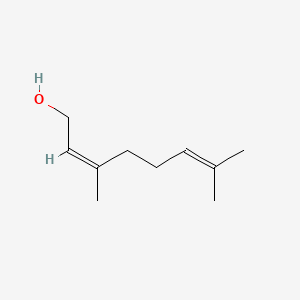| Authors | Title | Published | Journal | PubMed Link |
|---|---|---|---|---|
| Nishikitani M et al. | Geranyl 6-O-alpha-L-arabinopyranosyl-beta-D-glucopyranoside isolated as an aroma precursor from leaves of a green tea cultivar. | 1996 | Biosci. Biotechnol. Biochem. | pmid:8704326 |
| Szymańska I et al. | Fullerene modified supported lipid membrane as sensitive element of sensor for odorants. | 2001 | Biosens Bioelectron | pmid:11679270 |
| Chatterjee T | Biotransformation of geraniol by Rhodococcus sp. strain GR3. | 2004 | Biotechnol. Appl. Biochem. | pmid:15154841 |
| Pirozzi D and Halling PJ | Development of small-size tubular-flow continuous reactors for the analysis of operational stability of enzymes in low-water systems. | 2001 | Biotechnol. Bioeng. | pmid:11114661 |
| Barahona D et al. | Effect of water activity on the lipase catalyzed esterification of geraniol in ionic liquid [bmim]PF6. | 2006 | Biotechnol. Bioeng. | pmid:16196056 |
| Faria JM et al. | Biotransformation of menthol and geraniol by hairy root cultures of Anethum graveolens: effect on growth and volatile components. | 2009 | Biotechnol. Lett. | pmid:19205895 |
| de Roode BM et al. | Downstream processing of enzymatically produced geranyl glucoside. | 2001 Sep-Oct | Biotechnol. Prog. | pmid:11587579 |
| Marmulla R et al. | Linalool isomerase, a membrane-anchored enzyme in the anaerobic monoterpene degradation in Thauera linaloolentis 47Lol. | 2016 | BMC Biochem. | pmid:26979141 |
| Annadurai RS et al. | Next generation sequencing and de novo transcriptome analysis of Costus pictus D. Don, a non-model plant with potent anti-diabetic properties. | 2012 | BMC Genomics | pmid:23176672 |
| Eckert M and Schmidt U | The influence of permanent odor stimuli on the postnatal development of neural activity in the olfactory bulbs of laboratory mice. | 1985 | Brain Res. | pmid:4027664 |
| Vieira A et al. | Efficacy of geraniol but not of β-ionone or their combination for the chemoprevention of rat colon carcinogenesis. | 2011 | Braz. J. Med. Biol. Res. | pmid:21445532 |
| Barros LA et al. | In vitro larvicidal activity of geraniol and citronellal against Contracaecum sp (Nematoda: Anisakidae). | 2009 | Braz. J. Med. Biol. Res. | pmid:19787148 |
| Mo H et al. | Farnesyl anthranilate suppresses the growth, in vitro and in vivo, of murine B16 melanomas. | 2000 | Cancer Lett. | pmid:10936674 |
| Carnesecchi S et al. | Geraniol, a component of plant essential oils, modulates DNA synthesis and potentiates 5-fluorouracil efficacy on human colon tumor xenografts. | 2004 | Cancer Lett. | pmid:15374632 |
| Shoff SM et al. | Concentration-dependent increase of murine P388 and B16 population doubling time by the acyclic monoterpene geraniol. | 1991 | Cancer Res. | pmid:1988098 |
| Ong TP et al. | Farnesol and geraniol chemopreventive activities during the initial phases of hepatocarcinogenesis involve similar actions on cell proliferation and DNA damage, but distinct actions on apoptosis, plasma cholesterol and HMGCoA reductase. | 2006 | Carcinogenesis | pmid:16332721 |
| Polo MP et al. | Geraniol and simvastatin show a synergistic effect on a human hepatocarcinoma cell line. | 2011 | Cell Biochem. Funct. | pmid:21735455 |
| Malecki E et al. | Mitsunobu reactions of 5-fluorouridine with the terpenols phytol and nerol: DNA building blocks for a biomimetic lipophilization of nucleic acids. | 2013 | Chem. Biodivers. | pmid:24327441 |
| Ramilijaona J et al. | Enzymatic modification of palmarosa essential oil: chemical analysis and olfactory evaluation of acylated products. | 2013 | Chem. Biodivers. | pmid:24327448 |
| Ponzoni C et al. | Biotransformation of acyclic monoterpenoids by Debaryomyces sp., Kluyveromyces sp., and Pichia sp. strains of environmental origin. | 2008 | Chem. Biodivers. | pmid:18357555 |
Nerol
Nerol is a lipid of Prenol Lipids (PR) class. The involved functions are known as Odorant, Anabolism, Diastasis, Metabolic Inhibition and Oxidation. Nerol often locates in germ tube. The related lipids are Octanols, Pinene, Hexanols, ethyl butyrate and ethyl hexanoate.
Cross Reference
Introduction
To understand associated biological information of Nerol, we collected biological information of abnormalities, associated pathways, cellular/molecular locations, biological functions, related genes/proteins, lipids and common seen animal/experimental models with organized paragraphs from literatures.
What diseases are associated with Nerol?
There are no associated biomedical information in the current reference collection.
No disease MeSH terms mapped to the current reference collection.
PubChem Associated disorders and diseases
What pathways are associated with Nerol
There are no associated biomedical information in the current reference collection.
PubChem Biomolecular Interactions and Pathways
Link to PubChem Biomolecular Interactions and PathwaysWhat cellular locations are associated with Nerol?
Visualization in cellular structure
Associated locations are in red color. Not associated locations are in black.
Related references are published most in these journals:
| Location | Cross reference | Weighted score | Related literatures |
|---|
What functions are associated with Nerol?
Related references are published most in these journals:
| Function | Cross reference | Weighted score | Related literatures |
|---|
What lipids are associated with Nerol?
Related references are published most in these journals:
| Lipid concept | Cross reference | Weighted score | Related literatures |
|---|
What genes are associated with Nerol?
There are no associated biomedical information in the current reference collection.
What common seen animal models are associated with Nerol?
There are no associated biomedical information in the current reference collection.
